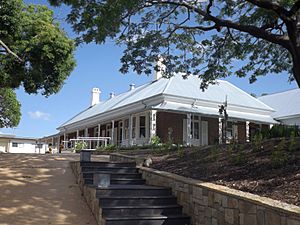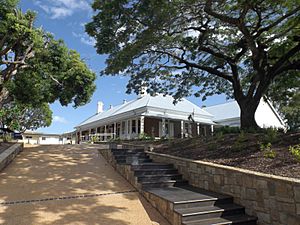Hanworth, East Brisbane facts for kids
Quick facts for kids Hanworth, East Brisbane |
|
|---|---|

Building in 2015
|
|
| Location | 109 Lytton Road, East Brisbane, Queensland, Australia |
| Design period | 1840s–1860s (mid-19th century) |
| Built | 1864-65 – 1930s circa |
| Architect | James Cowlishaw |
| Official name: Hanworth Home for the Aged, Hanworth, The Hospice | |
| Type | state heritage (landscape, built) |
| Designated | 21 December 1997 |
| Reference no. | 601026 |
| Significant period | 1860s, 1910s-1930s (fabric) 1860s-1890; 1910s (historical) |
| Significant components | trees/plantings, garden/grounds, residential accommodation – main house, lawn/s, fence/wall – perimeter, attic, furniture/fittings, driveway, dormitory wing |
| Lua error in Module:Location_map at line 420: attempt to index field 'wikibase' (a nil value). | |
Hanworth is a beautiful old house in East Brisbane, Australia. It's a special building because it's heritage-listed, which means it's protected for its history. The house was designed by James Cowlishaw and built between 1864 and the 1930s. It's also been known as the Hanworth Home for the Aged and The Hospice. It was added to the Queensland Heritage Register on 21 December 1997.
Contents
Hanworth: A Historic Home
Hanworth is a large brick house located near Norman Creek in East Brisbane. It was built in 1864-1865 for Lieutenant George Poynter Heath and his family. Heath was the Portmaster of Queensland, a very important job at the time. The house was designed by a well-known early Brisbane architect, James Cowlishaw.
When it was first built, Hanworth stood on over 7 acres of land. This land had a long border with Norman Creek. From the highest point near Lytton Road, the house had amazing views of the Brisbane River. In July 1863, George Heath bought this land. It was close to other grand homes along the river, like Eskgrove and Shafston House.
Building Hanworth in the 1860s
Work on Hanworth started by July 1864. The Heath family was important in Brisbane society. They chose James Cowlishaw to design their new home. Cowlishaw was Brisbane's first successful architect in private business. In the early 1860s, he had many big projects going on. This included Oakwal, another grand house.
The Heaths likely moved into Hanworth in the first half of 1865. They lived there for almost 25 years. They were part of Brisbane's highest society and often hosted parties. For example, when their daughter married in 1886, guests included the Governor and the Premier.
Who was George Poynter Heath?
George Poynter Heath (1830-1921) was born in Hanworth, England. He joined the navy in 1845. In 1859, he applied for a job as a marine surveyor in the new colony of Queensland. He arrived in Brisbane in August 1860.
In January 1862, Heath became the Portmaster of Queensland. He held this job for almost 30 years. During his time, he helped open 13 new ports, like Townsville and Cairns. He also set up 33 lighthouses and marked 450 miles of the inner route through the Barrier Reef. Heath was also involved in the Anglican Church. Streets and a park in East Brisbane are named after him.
The Architect: James Cowlishaw
James Cowlishaw worked as an architect in Brisbane from 1860 until around 1890. After that, he focused on his many other businesses. He even owned The Telegraph newspaper. Cowlishaw was a very successful architect in early Brisbane.
Hanworth Becomes a Home for Women
After Commander Heath retired in 1890, his family returned to England. Hanworth was then rented out. In 1909, the property was put up for sale. It was described as a "Substantial Brick Structure" with 8 rooms. The house didn't sell right away. In 1912, the land was divided into 57 smaller blocks for houses.
The house remained empty until Mrs. Mary Marguerite Wienholt bought it in July 1913. The land around the house was much smaller by then.
The Hospice and Theosophical Society
In 1913, Mrs. Wienholt opened a home at Hanworth. It was for elderly, poor gentlewomen. She named it The Hospice. She did this in memory of her mother. Mrs. Wienholt was part of the Theosophical Society. This group believed in universal brotherhood and studying different religions.
Mrs. Wienholt personally looked after the home. In 1927, she handed it over to the Brisbane Theosophical Society. They continued to run the home for almost 70 years. In 1995, the Anglican Church bought Hanworth. They renamed it the Hanworth Home for the Aged. It continued to house only women.
Fire and Restoration
In 2012, Marisa and Philip Vecchio bought Hanworth. They bought it in memory of Marisa's mother. They started big renovations to get the house ready for its 150th birthday. But in March 2013, a fire badly damaged the property.
However, the Vecchio family kept going with the restoration. They finished it in time for the anniversary. Their hard work was recognized with a top award from the National Trust of Australia in August 2014.
What Hanworth Looks Like
Hanworth is a single-storey brick house from the 1860s. It has wooden and brick additions. The house sits on a small hill above Lytton Road. A driveway leads from the road to the main entrance, which faces north. There's a garden with a lawn and pine trees between the road and the house.
The original part of Hanworth is shaped like a "U". It's made of unpainted red brick. The main front of the house faces north. A wide verandah (porch) goes around the front and sides. The original building is only one room deep. The roofs are made of corrugated iron. There are brick chimneys at each end of the roof. Most of the original windows, doors, and hardware are still there.
The verandah has a wooden floor. It has elegant cast-iron columns that hold up the curved roof. A wooden handrail and a modern metal fence run between the columns. The main front door is in the middle of the northern side. There are also French doors and a bay window. All the French doors have outside shutters.
Inside, a long hallway goes from the front door to a back door. The drawing room is to the right of the entrance. It has a beautiful white marble fireplace. The dining room has a large bay window and a black marble fireplace. These rooms still have furniture that might be from when Hanworth became a home for women.
The western side of the house has the kitchen and a wooden bedroom section. The kitchen is in the 1860s part of the building. The wooden part of this wing was likely added when the house became a hospice. It has 7 bedrooms and 2 bathrooms.
To the left of the entrance hall are three bedrooms. Two of these were made by dividing one larger original bedroom. The eastern side of the house has three bedrooms and an office. A staircase leads to an attic above the 1860s building. This attic was probably added when the Heath family lived there. At the back of the eastern wing, there's a two-storey brick addition from between the two World Wars. It contains more bedrooms and bathrooms.
Why Hanworth is Important
Hanworth Home for the Aged was listed on the Queensland Heritage Register on 21 December 1997. This means it meets certain important standards.
Showing Queensland's History
Hanworth was built in 1864-1865. It helps us understand how East Brisbane developed early on. It's one of the oldest houses still standing in the area. Like other nearby homes, Hanworth shows us the grand riverside estates that existed in the mid-1800s.
Unique Aspects of Queensland's Past
Hanworth is important because it's one of the earliest surviving houses in East Brisbane. It shows a rare part of Queensland's cultural history.
Learning About Building Techniques
The house can also teach us more about how buildings were made in Brisbane in the 1860s. It can also show us more about the work of early Brisbane architect James Cowlishaw.
A Great Example of Its Type
Even though the land around it is smaller now, the house itself is one of the most complete 1860s homes in Brisbane. It's a great example of its style. The simple U-shaped building, with its roof, curved verandah, and red brick, looks elegant and balanced. Inside, the rooms still show their original design. Many original features like doors, windows, and architraves are still there.
Beautiful Design and Location
The oldest part of Hanworth is important for its beauty and design. It was built on a hill, giving it lovely views of the Brisbane River and Norman Creek.
Connected to Important People
The place is important because of its long connection to George Poynter Heath. He was Queensland's first Portmaster. During his time (1862 to 1890), he helped set up many of Queensland's main ports. He also made the Queensland coast safer for ships by building many lighthouses and markers. Hanworth is also important for its long connection to Mary Marguerite Wienholt and the Brisbane Theosophical Society. They provided care for elderly women.
Images for kids



